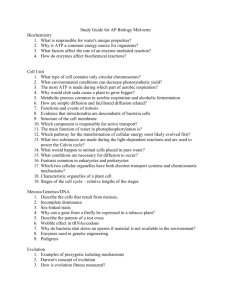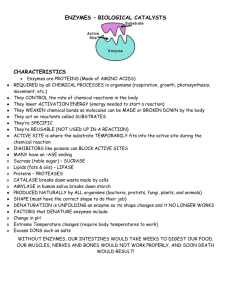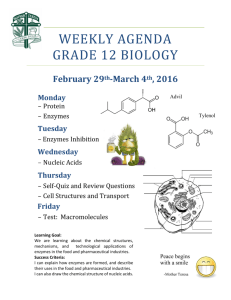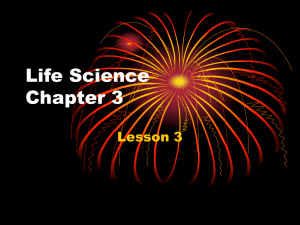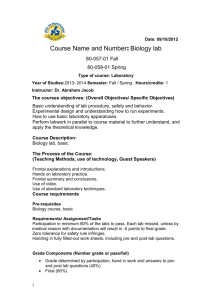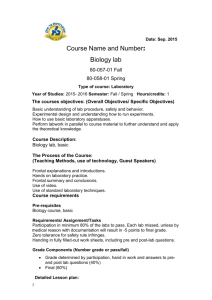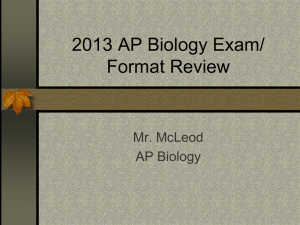AP Biology 12 Labs
advertisement
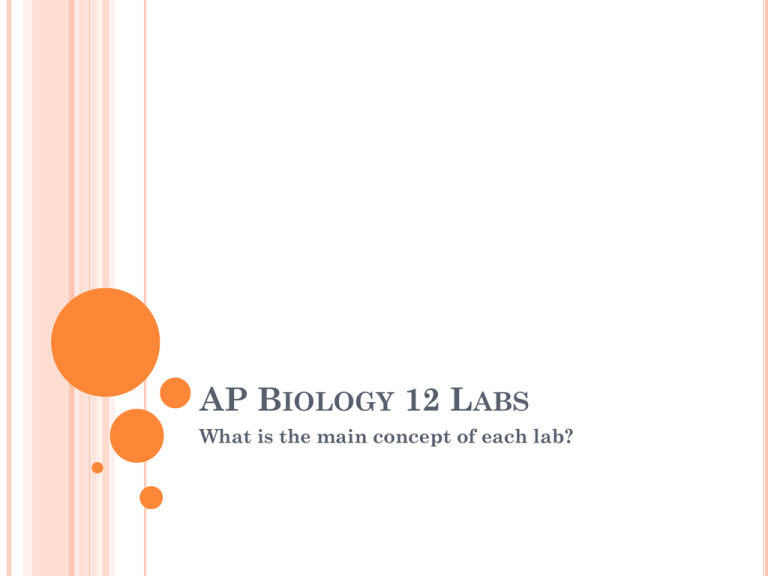
AP BIOLOGY 12 LABS What is the main concept of each lab? LAB 1: DIFFUSION AND OSMOSIS Semi-permeable membrane Must be small enough to fit through pores Transport proteins Active transport Glucose/Starch/Iodine 6 varying M of solutions placed in distilled water 1 piece of potato placed in 6 varying solutions % change = Final-initial/initial x 100 LAB 2: ENZYMES Speeds up reactions 2H2O2 O2 + 2H2O Catalase speeds up This lab measured the rate (what else to measure?) Disappearance of substrates or appearance of products Normally will have a maximum rate when all enzymes working Stopped enzyme by using acid to denature Could use salinity or temp Disrupts 4*, 3* or 2* bonds, esp the active site KMNO4 was an indicator pink meant no more H2O2 LAB 3: MITOSIS AND MEIOSIS Onion root cells b/c dividing rapidly (div/elong/maturation, meristem, etc) Counted # of cells to determine longest part of cell cycle Interphase (G1, S, G2) vs. Mitosis (PMAT) and Cyotkinesis Meiosis = reduce chromosome # and increase variation Sordaria = fungi with sexual spores that show c.o. Measure rates by comparing % LAB 4: PIGMENTS AND PHOTOSYNTHESIS Pigments = proteins that use light energy to excited ePrimary = chlorophyll a/b Secondary = accessory = carotenoids = beta carotene and xanthophyll Separate using chromatography (paper and solvent, gas) Physical properties such as size, mass, polarity Rf value = distance pigment/ distance solvent Light rxns = capturing of light energy into electron carriers to be used to fix carbon Normally NADP, substitute DPIP (must be more…) Measure effect if (no light, boiled, combinations) Heat sink to remove light Spectrophotometer measures light passing through DPIP becomes more clear as it gets reduced LAB 5: RESPIRATION In PEAS!! Dry, germinating, beads C6H12O6 + 602 6CO2 + 6H2O + ATP Measure consumption or production Respirometer KOH removes CO2 Gas laws PV=nRT Loss of gas means decreased pressure water moved in Don’t forget anaerobic LAB 6: MOLECULAR BIOLOGY Transformation Taking up of foreign genes into host (bacteria) Requires restriction enzymes to cleave DNA, ligase to reseal Source = bacterial protection from invading viruses Use same restriction enzyme Need vector (plasmid) Heat shock to get plasmid in, CaCl2 to attract Grow on restrictive media to test Gel Electrophoresis Compare DNA samples (could require PCR if sample is small) Enzymes cut at sites that are unique RFLPs Separate based on size using gel with pores Use electricity as force Buffer to prevent damage LAB 7: GENETICS Examine offspring to determine pattern of inheritance Dom/rec, Codom, Incompl, Sex-linked, Multiple Alleles P1, F1, F2 Make predicitions Red x white (two options) Red x red Are you statistically correct? LAB 8: EVOLUTION Is evolution occuring? Hardy-Weinberg p+q = 1, p2+2pq+q2=1 Are allele values staying constant? Also help determine % of genotypes Black is recessive to pink. Can you count the # of recessive alleles? If occuring: Gene flow, gene drift, natural selection, mutation, non-random mating H-W’s conditions Heterozygote Advantage “a” never disappears Lab 9: Transpiration Lab 10: Circulatory Different heart rates and bp PQRS wave Ecto/Endo Lab 11: Animal Behavior Structures and Adaptations Innate vs. Learned Design Experiment Lab 12: Dissolved Oxygen and Primary Production DO varies according to temp, other dissolved nutrients Represents biological processes (photo and resp) Photo = produce O2 and produce food = primary productivity Gross (amount available + whatever was consumed) Net (amount available) Light, existing, dark Graphing!! Good titles, Good labels, Good units Extrapolation of data Design Control, limited variable, designated IV, DV Prediction of data
